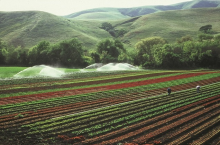
Excessive groundwater pumping, especially in intensively irrigated regions, is posing a threat to aquatic ecosystems worldwide, new research shows. According to a study published in the journal “Nature”, the water level of rivers and streams in many catchment areas where groundwater is pumped has already decreased and has become too low to sustain freshwater ecosystems. Rising water temperatures are threatening organisms living underwater, such as fish, plankton and water plants. The international team of researchers from Utrecht University, the water institute Deltares, the University of Freiburg (Germany) and the University of Victoria (Canada) used a global hydrological model to calculate the inflow of groundwater to the world’s network of streams and rivers around the world. “If we continue to pump as much groundwater in the coming decades as we have done so far, a critical point will be reached also for regions in southern and central Europe, such as Portugal, Spain and Italy, as well as in North African countries,” says hydrologist Dr. Inge de Graaf from the University of Freiburg. Also at risk are areas where groundwater supplies have remained relatively constant but rivers are no longer able to maintain healthy ecosystems.
“When groundwater levels drop, discharges from groundwater to streams decline, reverse in direction or even stop completely, thereby decreasing streamflow, with potentially devastating effects on aquatic ecosystems,” the authors write. “The effects can be seen already in the Midwest of the United States and in the Indus Valley project between Afghanistan and Pakistan,” de Graaf explains. If we keep pumping groundwater at the current rate, the world’s groundwater sites will be unable to sustain aquatic ecosystems by 2050. The researchers used different climate change models (the driest, wettest, and average climate projections in terms of precipitation change) in order to predict how streamflow will diminish in future. Their results showed that the flow of streams and rivers in almost 20% of the catchments areas where groundwater is pumped is already too low to sustain aquatic ecosystems. By 2050, limits will be reached for more than half of the watersheds: 42% of the world’s groundwater sites will be unable to sustain aquatic ecosystems by 2050 if the wettest scenario is considered and the figure increases to approximately 79% for the driest scenario. “Climate change may even accelerate this process, as we expect less precipitation, which will further increase the extraction of groundwater and cause dry areas to dry out completely,” de Graaf says.
Over the last 50 years, population growth and economic development have led to a large increase in freshwater demand, especially for the irrigation of food crops. “About 70% of the pumped groundwater worldwide is used to sustain irrigation,” according to the study. About half the water used for irrigation is pumped from groundwater. In many dry regions around the world, more groundwater is pumped than is recovered from rain, leading to a drop in water levels. “When the groundwater level drops, pumping costs increase, potentially resulting in a rise in food prices. When wells run dry, local and possibly larger-scale food security can be threatened,” the authors warn. They point out that some agricultural wells in the USA are already up to 300 m deep. Around the globe, riverbeds are close to running dry, especially in regions in which groundwater has been extracted over many years. This could have a devastating impact for aquatic ecosystems. “It’s pretty clear that if there’s no water in your stream anymore that your fish and plants are going to die,” de Graaf told news agency AFP. Co-author Marc Bierkens, Professor of Hydrology at Utrecht University, adds: “What is striking about our results is that a small drop in the water table can cause a major reduction in groundwater influx to streams and rivers. This shows that riverine freshwater ecosystems are extremely sensitive to water table decline.” The study also shows that it often takes decades for groundwater pumping to lead to a noticeable reduction of groundwater influx. This is turning unsustainable groundwater withdrawals into a ‘ticking time bomb’ for streamflow, the authors conclude. However, there are also promising solutions, such as sustainable and efficient groundwater use in agriculture. (ab)
